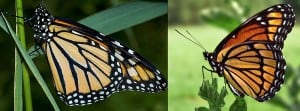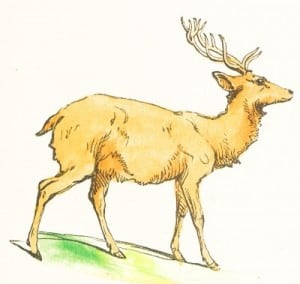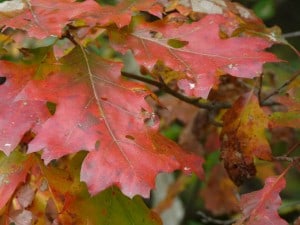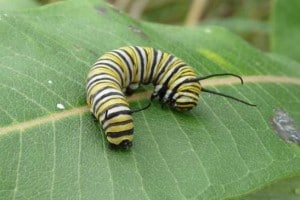Over the past few years, I’ve become increasingly interested in how to make people more aware of evolution and how it manifests itself in even the most common backyard species. The evolutionary “story” of the Monarch is every bit as compelling as that of the whale. Understanding how the pressures of the environment have shaped the behaviour and appearance of plants and animals – through the process of evolution – adds a great deal to our enjoyment of nature. Little by little, all of the life that surrounds us becomes far more interesting and wondrous.
A focus on the wonder of evolution will be a big part of the up-coming nature activity book that I’m writing with Jacob Rodenburg of Camp Kawartha. This week, I would like to share a few examples from the book that deal with this important theme.
Can you Deeg it?
Here is a story to help kids better understand how evolution works. We’ll see how small mutations (mistakes or errors in the genes) can lead to big changes – so big that one species can even split into two. How? Let’s imagine a species of deer-like animals that live in a grassy valley. We will call them Deegs. Male and female Deegs can breed (have babies together) because they are members of the same species and find each other attractive.
However, let’s see what happens when some of the Deegs are forced to move into a nearby, but isolated, valley. Imagine, too, that instead of tender grasses to eat, there are only trees with tough, leathery leaves. An ability to eat and digest grasses is essential for survival in the original valley but being able to reach up, then chew, and digest tough tree leaves is necessary in the second.
Slowly, over many generations, differences would start to appear in the Tree Valley Deegs, because of mutations. Natural selection – “nature” deciding who will survive – would favour any Deegs that are born with bigger and tougher teeth and mouths as well as longer necks. In other words, Deegs with these characteristics would have a better chance of surviving and passing on their genes.
Now imagine that once every few generations a Deeg from one valley wanders into the other valley and wants to mate. For many years, mating would be possible because they would still be the same species. However, as the generations go by and differences in the genes continue to build up, it would become harder and harder for the Deegs from the two valleys to produce healthy babies together. For example, female Deegs from one valley may no longer find the males from the other valley attractive and refuse to mate. When it becomes virtually impossible for the Deegs from one valley to breed with the Deegs from the other valley, they would have evolved into two distinct species.
Leaves = evolution!
September is a month when our attention is drawn to the beautiful colour display of leaves. For much of the year, however, leaves can easily be taken for granted. To help children appreciate just how amazing these structures really are, ask them to look closely at a tree leaf, to feel it and to describe it. Then, ask some of the following questions:
• Why does a tree have leaves? (to capture sunlight and take in carbon dioxide and in order to use photosynthesis to make the food it needs to grow)
• Why are leaves green for most the year? (green is the colour of chlorophyll, the pigment or molecule that absorbs the sunlight used in photosynthesis)
• Why do leaves change colour? (as summer ends, the chlorophyll in the leaf decomposes and other pigments – e.g., yellow, orange, brown – that were previously hidden become visible)
• What are some of the challenges or problems a leaf faces? (getting eaten, drying out, over-heating from exposure to the sun, etc.)
• Why do you think these pine leaves (needles) might be so hard and waxy? (conserve water, deter insects)
• Why do you think some leaves are so fuzzy or leathery? (conserve water, deter insects)
• Why do leaves come in different sizes? (small leaves conserve water better and don’t heat up so much in the sun; large leaves gather more light and therefore necessary in shady areas or low down in a tree)
• Why do leaves come in different shapes and have different edges? (complex edges and lobes allow leaves to get rid of absorbed heat more quickly; smooth edges are more common in shade-loving plants since heat absorption is less a problem)
Viceroys and monarchs
The next time you think you’ve see a Monarch butterfly, be careful that you are not actually looking at its look-alike cousin, the Viceroy. These two species have evolved near-identical wing colours and patterns. However, they are only distantly related. The reason they look so similar is because of mimicry, which is the ability of a species to imitate something other than what it really is. Why would mimicry have evolved? In the case of the Viceroy, the purpose is to trick predators into thinking that it is an inedible species. Predators quickly learn that Monarchs are distasteful and eating them causes vomiting. They therefore learn to avoid them. Viceroys therefore find protection by closely resembling their distant cousins. However, there is also some newer research showing that the Viceroy itself may actually be poisonous and that both the Viceroy and Monarch mimic each other. Now, isn’t evolution amazing!

Monarch (left) and Viceroy Comparison – Can you see the difference on the lower (hind) wing? Wikipedia
BIG IDEA: Metamorphosis
The Monarchs that we see flying south in September have just recently completed an amazing transformation known as metamorphosis. This is the process by which an animal continues to develop and change its body structure and behaviour, even after hatching out of the egg. Some animals that undergo metamorphosis include amphibians, insects, molluscs and crustaceans. In insects, metamorphosis can be incomplete or partial (egg, nymph, adult) or complete (egg, larva, pupa, adult).
In incomplete metamorphosis, the immature stages are called nymphs. Nymphs closely resemble adults but are smaller and lack wings. Some common insects that go through this kind of metamorphosis include grasshoppers and dragonflies. This type of metamorphosis evolved first and is therefore much more ancient than complete metamorphosis.
In complete metamorphosis, the immature stages are called larva. Depending on the insect group, other terms such as caterpillar, grub, maggot, etc. are also used. Unlike nymphs, larvae look very different from adults. Larvae eventually enter an inactive or resting state known as a pupa. In the case of butterflies and moths, we often use the terms ‘chrysalis’ and ‘cocoon.’ During pupation, adult body structures replace the larval structures. The adult emerges from the pupal stage.
Metamorphosis has long been a cause of misunderstanding and mysticism. One early scientist even thought that metamorphosis in butterflies began by the accidental mating of two different species: one, an earth-bound crawler and the other, an airborne flitter! Scientists now use the theory of evolution to explain how a larval and pupal stage came to be. They believe that the larval stage is actually a walking form of the embryo that was developing in the egg. Rather than continue to develop in the egg, natural selection found it to be more advantageous to the animal to get out of the egg as soon as possible and simply to continue to develop while on the move. Scientists think of the pupa as very similar to the nymph stage in incomplete metamorphosis. The difference, however, is that the pupa goes through all of the nymph stages while resting and being completely immobile.
CLIMATE CHANGE RALLY
A Climate Change Rally will take place at Millennium Park on Sunday, September 21, from 1:30 to 2:30 PM. The goal of the Rally is two-fold: to explain the impacts climate change is already having right here in the Kawarthas and to encourage local, provincial and federal politicians to take decisive action to mitigate the problem. The event is being organized by the Peterborough chapter of For Our Grandparents and is part of the Purple Onion Festival.


